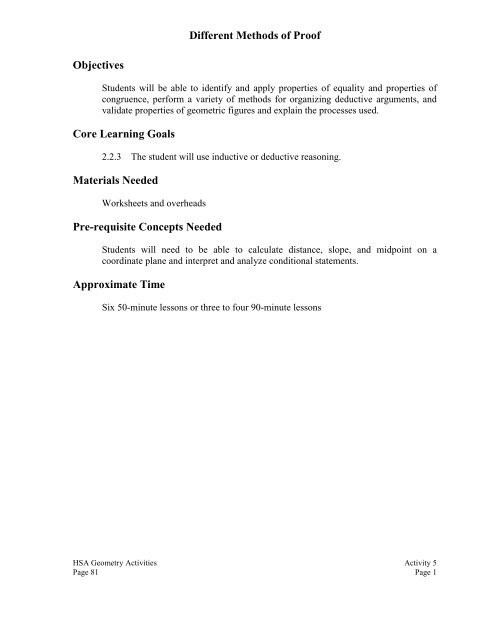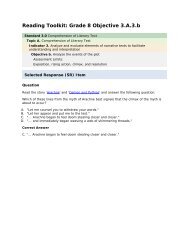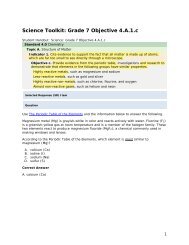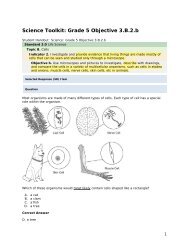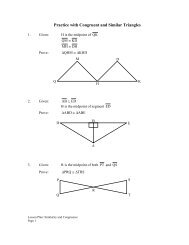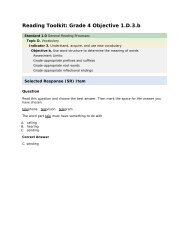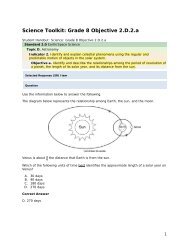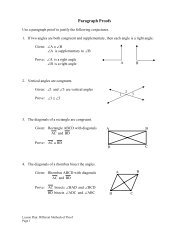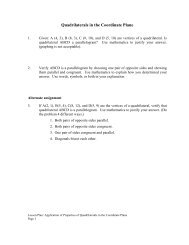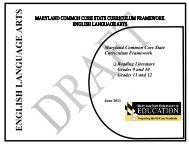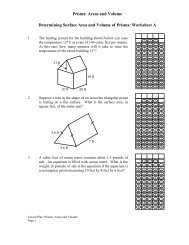MSDE Geometry Activity: - mdk12
MSDE Geometry Activity: - mdk12
MSDE Geometry Activity: - mdk12
Create successful ePaper yourself
Turn your PDF publications into a flip-book with our unique Google optimized e-Paper software.
Different Methods of Proof<br />
Objectives<br />
Students will be able to identify and apply properties of equality and properties of<br />
congruence, perform a variety of methods for organizing deductive arguments, and<br />
validate properties of geometric figures and explain the processes used.<br />
Core Learning Goals<br />
2.2.3 The student will use inductive or deductive reasoning.<br />
Materials Needed<br />
Worksheets and overheads<br />
Pre-requisite Concepts Needed<br />
Students will need to be able to calculate distance, slope, and midpoint on a<br />
coordinate plane and interpret and analyze conditional statements.<br />
Approximate Time<br />
Six 50-minute lessons or three to four 90-minute lessons<br />
HSA <strong>Geometry</strong> Activities <strong>Activity</strong> 5<br />
Page 81 Page 1
Lesson Plan – Justification in Proof<br />
Essential Questions<br />
Different Methods of Proof<br />
How can deductive reasoning be used to validate conjectures?<br />
What methods can be used to organize a deductive argument?<br />
Warm-Up/Opening <strong>Activity</strong><br />
Solve a two-step equation.<br />
Development of Ideas<br />
Overhead: What is a Proof?<br />
Justify the steps to solve an equation using the properties of equality.<br />
Identify and apply the properties of equality and the properties of congruence to<br />
geometric figures.<br />
Worksheet: Justification Using Properties of Equality and Congruence<br />
Answers: 1. Transitive Property<br />
2. Transitive Property of Congruence<br />
3. Subtraction Property<br />
4. Transitive Property<br />
5. Division Property<br />
6. Addition Property<br />
7. Transitive Property of Congruence<br />
8. Reflexive Property of Congruence<br />
9. Substitution Property<br />
10. Symmetric Property of Congruence<br />
11. 1. Given<br />
2. Additive Property<br />
3. Subtractive Property<br />
4. Division Property<br />
12. 1. Given<br />
2. Given<br />
3. Substitution Property<br />
4. Subtraction Property<br />
HSA <strong>Geometry</strong> Activities <strong>Activity</strong> 5<br />
Page 82 Page 2
Development of Ideas (Continued)<br />
Closure<br />
Different Methods of Proof<br />
Answers to Justification Using Properties of Equality & Congruence (Continued)<br />
13. 1. Given<br />
2. Given<br />
3. Subtraction Property<br />
4. Given<br />
5. Given<br />
6. Subtraction Property<br />
7. Transitive Property<br />
14. 1. Given<br />
2. Given<br />
3. Transitive Property<br />
4. Reflexive Property<br />
5. Subtraction Property<br />
Compare and contrast inductive and deductive reasoning.<br />
Worksheet: Comparison of Inductive and Deductive Reasoning<br />
HSA <strong>Geometry</strong> Activities <strong>Activity</strong> 5<br />
Page 83 Page 3
Different Methods of Proof<br />
What is a Proof?<br />
A proof is a convincing argument that something is true. In<br />
mathematics, a proof starts with things that are agreed upon, called postulates or<br />
axioms, and then uses logic to reach a conclusion.<br />
Conclusions are often reached in geometry by observing data and looking<br />
for patterns. This type of reasoning is called inductive reasoning. The<br />
conclusion reached by inductive reasoning is called a conjecture.<br />
A proof in geometry consists of a sequence of statements, each supported<br />
by a reason, that starts with a given set of premises and leads to a valid<br />
conclusion. This type of reasoning is called deductive reasoning. Each<br />
statement in a proof follows from one or more of the previous statements. A<br />
reason for a statement can come from the set of given premises or from one of<br />
the four types of other premises: definitions; postulates; properties of algebra,<br />
equality, or congruence; or previously proven theorems. Once a conjecture is<br />
proved, it is called a theorem. As a theorem, it becomes a premise for<br />
geometric arguments you can use to prove other conjectures. The four common<br />
methods of geometric proofs are: 1) two-column proofs, 2) paragraph proofs,<br />
3) flow chart proofs, and 4) coordinate proofs.<br />
HSA <strong>Geometry</strong> Activities <strong>Activity</strong> 5<br />
Page 84 Page 4
Different Methods of Proof<br />
Justification Using Properties of Equality and Congruence<br />
PROPERTIES OF EQUALITY FOR REAL NUMBERS<br />
Reflexive Property For any number a, a = a.<br />
Symmetric Property For any numbers a and b, if a = b then b = a.<br />
Transitive Property For any numbers a, b and c, if a = b and b = c, then a = c.<br />
Addition and Subtraction<br />
Properties<br />
Multiplication and Division<br />
Properties<br />
Substitution Property<br />
For any numbers a, b and c, if a = b, then a + c = b + c<br />
and a – c = b – c.<br />
For any numbers a, b and c, if a = b, then a×c = b×c and<br />
if c ≠ 0, then a÷c = b÷c.<br />
For any numbers a and b, if a = b, then a may be replaced<br />
with b in any equation.<br />
PROPERTIES OF CONGRUENCE<br />
Reflexive Property of Congruence AB ≅ AB<br />
Symmetric Property of Congruence If AB ≅ CD , then CD ≅ AB<br />
Transitive Property of Congruence If AB ≅ CD and CD ≅ EF, then AB ≅ EF<br />
HSA <strong>Geometry</strong> Activities <strong>Activity</strong> 5<br />
Page 85 Page 5
Different Methods of Proof<br />
Justification Using Properties of Equality and Congruence (Continued)<br />
State the property of equality or property of congruence that justifies each conclusion.<br />
1. Given: m∠ 1=<br />
m∠2<br />
m∠ 2=<br />
75<br />
Conclusion: m∠ 1=<br />
75<br />
2. Given: EG ≅ FG<br />
FG ≅ GH<br />
Conclusion: EG ≅ GH<br />
3. Given: x + 9 = 13<br />
Conclusion: x = 4<br />
4. Given: JK = KL<br />
MN = KL<br />
Conclusion: JK = MN<br />
5. Given: 7x = 63<br />
Conclusion: x = 9<br />
6. Given: m∠ 3=<br />
65<br />
m∠ 4=<br />
65<br />
Conclusion: m∠ 3+ m∠ 4=<br />
130<br />
7. Given: ∠1 ≅∠2<br />
∠2≅∠3<br />
Conclusion: ∠1≅∠3<br />
8. Given: XY is a segment<br />
Conclusion: XY ≅ XY<br />
9. Given: 2x + y = 70<br />
y = 3x<br />
Conclusion: 2x + 3x = 70<br />
10. Given: ∠A ≅∠B<br />
Conclusion: ∠B ≅∠A<br />
HSA <strong>Geometry</strong> Activities <strong>Activity</strong> 5<br />
Page 86 Page 6
Different Methods of Proof<br />
Justification Using Properties of Equality and Congruence (Continued)<br />
Supply the missing reasons for each of the following:<br />
11.<br />
Given: 15y + 7 = 12 - 20y<br />
1<br />
Conclusion: y =<br />
7<br />
Statement<br />
Reason<br />
1. 15y + 7 = 12 - 20y 1.<br />
2. 35y + 7 = 12 2.<br />
3. 35y = 5 3.<br />
4.<br />
1<br />
y = 4.<br />
7<br />
12.<br />
Given: m∠+ 1 m∠ 2 = 100<br />
m∠ 1=<br />
80<br />
Conclusion: m∠ 2=<br />
20<br />
Statement<br />
Reason<br />
1. m∠+ 1 m∠ 2 = 100<br />
1.<br />
2. m∠ 1= 80<br />
2.<br />
3. 80 + m∠ 2 = 100<br />
3.<br />
4. m∠ 2= 20<br />
4.<br />
HSA <strong>Geometry</strong> Activities <strong>Activity</strong> 5<br />
Page 87 Page 7
Different Methods of Proof<br />
13.<br />
Justification Using Properties of Equality and Congruence (Continued)<br />
Given: m ∠ 1 = 40<br />
m ∠ 2 = 40<br />
m ∠ 1 + m ∠ 3 = 80<br />
m ∠ 4 + m ∠ 2 = 80<br />
Conclusion: m ∠ 3 = m ∠ 4<br />
Statement<br />
Reason<br />
1. m ∠ 1 + m ∠ 3 = 80 1.<br />
2. m ∠ 1 = 40 2.<br />
3. m ∠ 3 = 40 3.<br />
4. m ∠ 4 + m ∠ 2 = 80 4.<br />
5. m ∠ 2 = 40 5.<br />
6. m ∠ 4 = 40 6.<br />
7. m ∠ 3 = m ∠ 4 7.<br />
14.<br />
Given: m ∠ 1 + m ∠ 2 = 180<br />
m ∠ 2 + m ∠ 3 = 180<br />
Conclusion: m ∠ 1 = m ∠ 3<br />
Statement<br />
Reason<br />
1. m ∠ 1 + m ∠ 2 = 180 1.<br />
2. m ∠ 2 + m ∠ 3 = 180 2.<br />
3. m ∠ 1 + m ∠ 2 = m ∠ 2 + m ∠ 3 3.<br />
4. m ∠ 2 = m ∠ 2 4.<br />
5. m ∠ 1 = m ∠ 3 5.<br />
HSA <strong>Geometry</strong> Activities <strong>Activity</strong> 5<br />
Page 88 Page 8
Different Methods of Proof<br />
Comparison of Inductive and Deductive Reasoning<br />
Inductive Reasoning Process:<br />
Observations:<br />
51 o<br />
38 o<br />
55 o<br />
40 o 55o<br />
85 o<br />
104 o<br />
70 o 38 o 59 o<br />
64 o + 61 o + 55 o = 180 o<br />
70 o + 59 o + 51 o = 180 o<br />
40 o + 55 o + 85 o = 180 o<br />
38 o + 38 o + 104 o = 180 o<br />
64 o 61 o y<br />
Generalizations:<br />
Conjecture: a + b + c = 180 o<br />
for all triangles!<br />
Deductive Reasoning Process:<br />
x<br />
b<br />
a<br />
c<br />
Facts accepted as true:<br />
Fact 1: x + b + y = 180 o because x, b, and y are measures of angles that form a<br />
straight angle.<br />
Fact 2: x = a and y = c because alternate interior angles are congruent when<br />
parallel lines are cut by a transversal.<br />
Fact 3: We can substitute equal values for equal values.<br />
Logical consequences:<br />
Conclusion: a + b + c = 180 o for any triangle.<br />
HSA <strong>Geometry</strong> Activities <strong>Activity</strong> 5<br />
Page 89 Page 9
Lesson Plan – Flow Chart Proofs<br />
Essential Questions<br />
Different Methods of Proof<br />
How can deductive reasoning be used to validate conjectures?<br />
What methods can be used to organize a deductive argument?<br />
Warm-Up/Opening <strong>Activity</strong><br />
Write the directions for making a sandwich in a flow chart.<br />
Teacher Note: You might want to have the ingredients to make a sandwich available<br />
in class.<br />
Development of Ideas<br />
Arrange in order the steps to solve an algebraic equation.<br />
Teacher Note: Have the students work in groups for problems 5, 6, and 7. Each<br />
group of students will need an envelope with the statements and<br />
reasons for each problem cut into strips and a copy of the flowchart<br />
template for each problem. The master copies follow the worksheet.<br />
Justify the steps to solve the algebraic equation in a flow chart format.<br />
Worksheet: Introduction to Flow Chart Proofs<br />
Answers: 1. c. 3x-15 = 150 ! 3x = 165 ! x = 55<br />
Given Addition Division<br />
Equation Property Property<br />
d.-e.<br />
of Equality of Equality<br />
The first box is the ‘if’ statement and the<br />
last box is the ‘then’ statement.<br />
2. a. Given ! Multiplication Property of<br />
Equality ! Division Property of<br />
Equality<br />
b.-c.<br />
The first box is the ‘if’ statement and the<br />
last box is the ‘then’ statement.<br />
3. 3x+28= 58 ! 3x = 30 ! x = 10<br />
Given Subtraction Division<br />
Equation Property Property<br />
of Equality of Equality<br />
HSA <strong>Geometry</strong> Activities <strong>Activity</strong> 5<br />
Page 90 Page 10
Development of Ideas (Continued)<br />
Different Methods of Proof<br />
Answers to Introduction to Flow Chart Proofs (Continued)<br />
4. 5x-12=x-32 ! 4x-12=-32 ! 4x=-20 ! x =-5<br />
Given Subtraction Addition Division<br />
Equation Property Property Property<br />
of Equality of Equality of Equality<br />
5. a. Given: ∠ 1 and ∠ 2 are supplementary<br />
∠2 ≅ ∠3<br />
Prove: ∠ 1+<br />
∠3<br />
= 180º<br />
b.<br />
∠1 and ∠2 are<br />
supplementary<br />
Given<br />
m∠1 =<br />
m∠2<br />
Given<br />
m∠1 + m∠2 =<br />
180°<br />
Definition of<br />
supplementary<br />
angles<br />
∠2 ≅ ∠3 m∠2 = m∠3 m∠1 + m∠3 = 180°<br />
Given<br />
Definition of<br />
congruent<br />
angles<br />
Substitution<br />
property of equality<br />
c.-d. The first box is the ‘if’ statement and the<br />
last box is the ‘then’ statement.<br />
6. a. Given: m ∠ 1 = m ∠ 2<br />
Prove: m ∠ AEC = m ∠ BED<br />
b.<br />
m∠1 + m∠3 =<br />
m∠2 + m∠3<br />
Addition<br />
property of<br />
equality<br />
m∠AEC = m∠1 + m∠3<br />
m∠BED = m∠2 + m∠3<br />
Angle addition postulate<br />
m∠AEC = m∠BED<br />
Substitution property<br />
of equality<br />
7. a. Given: PR and QS bisect each other at T<br />
PR and QS bisect<br />
each other at T<br />
Given<br />
Prove: ∆PQT ≅∆RST<br />
PT ≅ TR<br />
Definition of bisector<br />
QT ≅ TS ∆PQT ≅∆RST<br />
Definition of bisector<br />
∠PTQ<br />
≅∠RTS<br />
Vertical angles are<br />
congruent<br />
Side-Angle-Side<br />
Congruence<br />
8. a. Given: PR and QS bisect each other at T<br />
Prove: ∠P ≅∠R<br />
c. Reasons:<br />
Definition of Bisector<br />
Given Definition of Bisector Side-angle-side Triangle<br />
Congruency<br />
Definition of Vertical<br />
Angles<br />
HSA <strong>Geometry</strong> Activities <strong>Activity</strong> 5<br />
Page 91 Page 11
Development of Ideas (Continued)<br />
Different Methods of Proof<br />
Answers to Introduction to Flow Chart Proofs (Continued)<br />
9. b. Given: ∠ A and ∠ B are complementary<br />
∠ B and ∠ C are complimentary<br />
Prove: ∠ A ≅ ∠ C<br />
c.<br />
∠ A and ∠ B are<br />
complementary<br />
Given<br />
Justify geometric properties using a flow chart.<br />
∠ B and ∠ C are<br />
complimentary<br />
Given<br />
∠ A + ∠ B = 90º ∠ B + ∠ C = 90º<br />
Definition of<br />
Definition of<br />
Complementary Angles<br />
Complementary Angles<br />
∠ A + ∠ B = ∠ B + ∠ C<br />
Transitive Property of<br />
Equality<br />
∠ B ≅ ∠ B<br />
Reflexive Property of<br />
Congruence<br />
∠ A ≅ ∠ C<br />
Subtraction Property<br />
Worksheet: Flow Chart Proofs<br />
Answers: 1.<br />
AR ≅ ER<br />
Given<br />
AC ≅ EC<br />
Given<br />
∆RCE<br />
≅ ∆RCA<br />
Side-side-side<br />
triangle congruence<br />
∠E<br />
≅ ∠A<br />
Definition of<br />
congruent triangles or<br />
CPCTC<br />
RC ≅ RC<br />
Reflexive Property<br />
of congruence<br />
HSA <strong>Geometry</strong> Activities <strong>Activity</strong> 5<br />
Page 92 Page 12
Development of Ideas (Continued)<br />
Different Methods of Proof<br />
Answers to Flow Chart Proofs (Continued)<br />
2.<br />
SE ≅ SU<br />
Given<br />
∠E ≅ ∠U<br />
Given<br />
∆SEM<br />
≅ ∆SUO<br />
Angle-Side-Angle<br />
triangle congruence<br />
MS ≅ SO<br />
Definition of<br />
congruent triangles or<br />
CPCTC<br />
∠1 ≅ ∠2<br />
Definition of<br />
Vertical Angles<br />
3.<br />
M is midpoint<br />
AM ≅ MB<br />
of AB<br />
Given<br />
Definition of<br />
midpoint<br />
M is midpoint<br />
of CD<br />
Given<br />
CM ≅ MD<br />
Definition of<br />
midpoint<br />
∆AMC<br />
≅ ∆BMD<br />
Side-angle-side<br />
triangle cong.<br />
AC ≅ BD<br />
Definition of<br />
triangle cong.<br />
or CPCTC<br />
4.<br />
Isosceles<br />
Given<br />
∠1 ≅ ∠2<br />
Vertical angles<br />
are congruent<br />
∆FGH<br />
FG ≅ FH<br />
Definition of<br />
isosceles triangle<br />
EF is a median<br />
Given<br />
GE ≅ HE<br />
Definition of<br />
median<br />
∆GFE<br />
≅ ∆HFE<br />
Side-side-side<br />
triangle cong.<br />
EF ≅ EF<br />
Reflexive Property<br />
of congruence<br />
HSA <strong>Geometry</strong> Activities <strong>Activity</strong> 5<br />
Page 93 Page 13
Different Methods of Proof<br />
Closure<br />
Describe the advantages and disadvantages of writing instructions for a task in a flow<br />
chart.<br />
Answer:<br />
An advantage of using flow charts is to be able to show different<br />
directions and logic pathways within the sequence of directions. A<br />
disadvantage is that the pathways can be confusing and difficult to see<br />
at first.<br />
Describe how deductive reasoning is used in flow charts.<br />
Answer:<br />
Flow charts show how deductive reasoning is developed by using the<br />
given statements, definitions, and theorems to demonstrate proofs and<br />
showing how the connections are made.<br />
HSA <strong>Geometry</strong> Activities <strong>Activity</strong> 5<br />
Page 94 Page 14
Different Methods of Proof<br />
Introduction to Flow Chart Proofs<br />
A flow chart proof is a concept map that shows the statements and reasons needed for a<br />
proof in a structure that helps to indicate the logical order. Statements, written in the logical<br />
order, are placed in the boxes. The reason for each statement is placed under that box.<br />
1. a. Cut out the individual boxes of statements and reasons at the bottom of the page.<br />
b. Arrange the statements and reasons to prove the following conditional:<br />
If 3x − 15 = 150 then x = 55.<br />
c. Copy the statements and reasons in the proper order on the flowchart displayed<br />
below. Place the statements in the boxes and the reasons on the lines below the boxes.<br />
Start<br />
End<br />
d. What is the statement in the first box? How does it relate to the conditional?<br />
e. What is the statement in the last box? How does it relate to the conditional?<br />
Cut out:<br />
x = 55<br />
Addition Property<br />
of Equality<br />
3x = 165<br />
Division Property<br />
of Equality<br />
3x − 15 = 150<br />
Given equation<br />
HSA <strong>Geometry</strong> Activities <strong>Activity</strong> 5<br />
Page 95 Page 15
Different Methods of Proof<br />
Introduction to Flow Chart Proofs (Continued)<br />
2. Prove the following conditional:<br />
If 4 x<br />
24<br />
7 = , then x = 42.<br />
a. The statements are already entered into the flowchart. Write the correct reasons below<br />
each box.<br />
Start<br />
4x<br />
7 = 24<br />
4x = 168<br />
x = 42<br />
End<br />
b. What is the statement in the first box? How does it relate to the conditional?<br />
c. What is the statement in the last box? How does it relate to the conditional?<br />
3. Prove the following conditional:<br />
If 3x + 28 = 58, then x = 10.<br />
Write the correct statements and reasons in the flowchart to prove the conditional above.<br />
Start<br />
End<br />
4. Given the conditional:<br />
If 5x − 12 = x − 32, then x = -5.<br />
Write the correct statements and reasons in the flowchart to prove the conditional above.<br />
Start<br />
4x − 12 = −32<br />
End<br />
Addition Property<br />
HSA <strong>Geometry</strong> Activities <strong>Activity</strong> 5<br />
Page 96 Page 16
Different Methods of Proof<br />
Introduction to Flow Chart Proofs (Continued)<br />
5. The flowchart proof can be used to show the logical process in a proof of a geometric<br />
idea. For example, given the following conditional:<br />
If ∠ 1 and ∠ 2 are supplementary and ∠ 2 ≅ ∠ 3, then m∠ 1 + m∠ 3 = 180°.<br />
a. State the given and prove for this conditional.<br />
Given:<br />
Prove:<br />
1<br />
2<br />
3<br />
b. Sort the slips of paper from the envelope into statements and reasons. Then arrange<br />
the statements and reasons on the flowchart to give a logical proof of the conditional.<br />
c. What is the statement in the first box? How does it relate to the conditional?<br />
d. What is the statement in the last box? How does it relate to the conditional?<br />
6. Prove the following conditional:<br />
If m∠ 1 = m∠ 2, then m∠ AEC = m∠ BED.<br />
a. State the given and prove for this conditional.<br />
Given:<br />
E<br />
A<br />
1<br />
3<br />
2<br />
D<br />
B<br />
C<br />
Prove:<br />
b. Sort the slips of paper from the envelope into statements and reasons. Then arrange<br />
the statements and reasons on the flowchart to give a logical proof of the conditional.<br />
7. Prove the following conditional:<br />
If PR and QS bisect each other at T,<br />
then ∆PQT ≅∆ RST .<br />
a. State the given and prove for this conditional.<br />
P<br />
Q<br />
T<br />
R<br />
S<br />
Given:<br />
Prove:<br />
b. Sort the slips of paper from the envelope into statements and reasons. Then arrange<br />
the statements and reasons on the flowchart to give a logical proof of the conditional.<br />
HSA <strong>Geometry</strong> Activities <strong>Activity</strong> 5<br />
Page 97 Page 17
Different Methods of Proof<br />
Introduction to Flow Chart Proofs (Continued)<br />
8. Prove the following conditional:<br />
If PR and QS bisect each other at T,<br />
then ∠P≅∠ R .<br />
P<br />
T<br />
S<br />
a. Complete the following:<br />
Given:<br />
Prove:<br />
Q<br />
R<br />
b. Mark the information that is given on the diagram.<br />
c. Complete the missing parts of the flow chart proof.<br />
PR and QS bisect<br />
each other at T<br />
PT ≅ TR<br />
QT ≅ TS<br />
∠<br />
≅∠<br />
∆PQT<br />
≅ ∆RST<br />
P R<br />
∠PTQ<br />
≅∠RTS<br />
Definition of<br />
congruent triangles<br />
or CPCTC<br />
HSA <strong>Geometry</strong> Activities <strong>Activity</strong> 5<br />
Page 98 Page 18
Different Methods of Proof<br />
Introduction to Flow Chart Proofs (Continued)<br />
9. If ∠ A and ∠ B are complementary and ∠ B and ∠ C are complimentary, then<br />
∠ A ≅ ∠ C.<br />
a. Draw a diagram for this conditional.<br />
b. State the given and prove for this conditional in terms of the diagram.<br />
Given:<br />
Prove:<br />
c. Fill in the missing reasons in the flowchart below.<br />
Start<br />
Given<br />
m∠A+ m∠B = 90°<br />
m∠B+ m∠C = 90°<br />
Definition of complementary<br />
angles<br />
m∠A + m∠B = m∠B + m∠C<br />
Transitive Property<br />
of Equality<br />
m∠A = m∠C<br />
End<br />
HSA <strong>Geometry</strong> Activities <strong>Activity</strong> 5<br />
Page 99 Page 19
Different Methods of Proof<br />
Introduction to Flow Chart Proofs (Continued)<br />
Statements and Reasons for problem 5 flowchart proof<br />
∠1 and ∠2 are supplementary<br />
m∠1 + m∠3 = 180°<br />
m∠1 + m∠2 = 180°<br />
∠2 ≅ ∠3<br />
m∠2 = m∠3<br />
Given<br />
Definition of congruent angles<br />
Substitution property of equality<br />
Definition of supplementary angles<br />
Given<br />
Statements and Reasons for problem 6 flowchart proof<br />
m∠1 = m∠2<br />
m∠1 + m∠3 = m∠2 + m∠3<br />
m∠AEC = m∠1 + m∠3<br />
m∠BED = m∠2 + m∠3<br />
m∠AEC = m∠BED<br />
Angle addition postulate<br />
Substitution property of equality<br />
Given<br />
Addition property of equality<br />
Statements and Reasons for problem 7 flowchart proof<br />
PR and QS bisect each other at T<br />
PT ≅ TR<br />
QT ≅ TS<br />
Given<br />
Vertical angles are congruent<br />
Definition of bisector<br />
∠PTQ<br />
≅∠RTS<br />
Side-Angle-Side Congruence<br />
∆PQT<br />
≅∆RST<br />
Definition of bisector<br />
HSA <strong>Geometry</strong> Activities <strong>Activity</strong> 5<br />
Page 100 Page 20
Different Methods of Proof<br />
Introduction to Flow Chart Proofs (Continued)<br />
Flowchart for problem 5<br />
Flowchart for problem 6<br />
HSA <strong>Geometry</strong> Activities <strong>Activity</strong> 5<br />
Page 101 Page 21
Different Methods of Proof<br />
Introduction to Flow Chart Proofs (Continued)<br />
Flowchart for problem 7<br />
HSA <strong>Geometry</strong> Activities <strong>Activity</strong> 5<br />
Page 102 Page 22
Different Methods of Proof<br />
Flow Chart Proofs<br />
Fill in the missing reasons or statements in each proof.<br />
1. Given: AR ≅ ER<br />
AC ≅ EC<br />
A<br />
Prove: ∠E ≅∠A<br />
R<br />
C<br />
E<br />
Given<br />
AC ≅ EC<br />
∆RCE<br />
≅ ∆RCA<br />
RC ≅ RC<br />
Definition of<br />
congruent triangles<br />
or CPCTC<br />
Reflexive property<br />
of congruence<br />
2. Given: SE ≅ SU<br />
∠E<br />
≅∠U<br />
Prove: MS ≅ SO<br />
E<br />
1<br />
S<br />
2<br />
U<br />
M<br />
O<br />
SE<br />
≅ SU<br />
∆____<br />
≅ ∆____<br />
Given<br />
∠1≅∠2<br />
Angle-Side-Angle<br />
congruence<br />
Definition of<br />
congruent triangles<br />
or CPCTC<br />
HSA <strong>Geometry</strong> Activities <strong>Activity</strong> 5<br />
Page 103 Page 23
3. Given: M is the midpoint of AB .<br />
M is the midpoint of CD .<br />
Prove: AC ≅ BD<br />
M is the midpoint<br />
of AB .<br />
Different Methods of Proof<br />
Flow Chart Proofs (Continued)<br />
AM ≅ MB<br />
A<br />
C<br />
2<br />
M 1<br />
D<br />
B<br />
Given<br />
M is the midpoint<br />
of CD .<br />
Definition of<br />
midpoint<br />
∆____<br />
≅ ∆____<br />
Definition of<br />
midpoint<br />
Definition of<br />
congruent triangles<br />
or CPCTC<br />
Vertical angles are<br />
congruent.<br />
F<br />
4. Given: Isosceles ∆ FGH with base GH<br />
EF is a median<br />
Prove: ∆GFE ≅ ∆HFE<br />
Isosceles<br />
∆FGH<br />
G<br />
E<br />
H<br />
Definition of isosceles<br />
triangle<br />
EF is a median<br />
∆____<br />
≅ ∆____<br />
Definition of median<br />
EF ≅ EF<br />
HSA <strong>Geometry</strong> Activities <strong>Activity</strong> 5<br />
Page 104 Page 24
Different Methods of Proof<br />
Lesson Plan – Paragraph Proofs<br />
Essential Questions<br />
How can deductive reasoning be used to validate conjectures?<br />
What methods can be used to organize a deductive argument?<br />
Warm-Up/Opening <strong>Activity</strong><br />
Construct a flow chart demonstrating the steps taken to get ready for school.<br />
Development of Ideas<br />
Convert the boxes of the flowchart to sentences and form a paragraph showing the steps<br />
taken to get ready for school.<br />
Convert flow-chart proofs to paragraph proofs.<br />
Justify geometric properties in paragraph form.<br />
Worksheet: Introduction to Paragraph Proofs<br />
Answers: 1. a. The first sentence contains the given statements.<br />
b. The last sentence contains what is to be proved.<br />
2. Lines AB and CD are parallel and E is the midpoint of<br />
AD . Since the AB and CD are parallel, angles BAE and<br />
CDE are congruent because if two parallel lines are cut by<br />
a transversal, then alternate interior angles are congruent.<br />
For this same reason, angles ABE and DCE are congruent.<br />
Since E is the midpoint of AD , AE and ED are<br />
congruent. Therefore, by angle-angle-side triangle<br />
congruence, ∆ ABE is congruent to ∆ DCE .<br />
3. Since DG EF and DE GF are given, then ∠1 ≅∠4<br />
and ∠3<br />
≅∠2 because when two parallel lines are cut by a<br />
transversal, then alternate interior angles are congruent.<br />
DF ≅ DF because of the reflexive property of congruence.<br />
Then ∆ DGF ≅ ∆FED<br />
by angle-side-angle triangle<br />
congruence. Therefore, DG ≅ EF by the definition of<br />
triangle congruence.<br />
HSA <strong>Geometry</strong> Activities <strong>Activity</strong> 5<br />
Page 105 Page 25
Different Methods of Proof<br />
Development of Ideas (Continued)<br />
Answers to Introduction to Paragraph Proofs (Continued)<br />
4. Since AC bisects ∠ BAD is given, then ∠BAC<br />
≅∠CAD<br />
because of the definition of angle bisectors. Since AC<br />
bisects ∠ BCD is given, then ∠BCA<br />
≅∠ACD because of<br />
the definition of angle bisectors. AC ≅ AC because of the<br />
reflexive property of congruence. Then, ∆BAC<br />
≅∆DAC<br />
by the angle-side-angle triangle congruence theorem.<br />
Therefore AB ≅ AD by the definition of triangle<br />
congruence.<br />
5. Since ∠ E and ∠ S are right angles, they both measure 90<br />
degrees by the definition of right angles. Because of this,<br />
they are also congruent. We are also given that EF ≅ ST<br />
and ED ≅ SR . Because of this information,<br />
∆DEF<br />
≅ ∆ RST because of side-angle-side triangle<br />
congruence.<br />
Justify geometric properties in paragraph form.<br />
Worksheet: Paragraph Proofs<br />
Answers: 1. ∠A<br />
is congruent to ∠B<br />
and ∠ A is supplementary to ∠ B .<br />
Since the two angles are supplementary, their sum is 180º.<br />
Since they are congruent, they can be substituted for one<br />
another, meaning that ∠ A + ∠ B is equal to 180º, but also<br />
that 2 times ( ∠ B ) is equal to 180º. Then, ∠ B = 90º by the<br />
division property of equality. Since the two angles are<br />
congruent, ∠ A also = 90º. ∠ A and ∠B<br />
are right angles<br />
by the definition of right angles.<br />
2. ∠ 1 and ∠ 3 are vertical angles. Since they are vertical<br />
angles, there is an angle in between them, ∠ 2 , which is<br />
adjacent to both angles and supplementary to both angles.<br />
Since both ∠ 1 and ∠ 3 are supplementary to ∠ 2 , ∠ 1 +<br />
∠ 2 = 180º and ∠ 2 + ∠ 3 = 180º. ∠ 1 + ∠ 2 = ∠ 2 + ∠3<br />
by the application of the transitive property of equality. ∠1<br />
and ∠ 3 are congruent because to the subtraction property<br />
of equality.<br />
3. ABCD is a rectangle with AC and BD as diagonals. Since<br />
ABCD is a rectangle, opposite sides AB and CD are<br />
congruent. In addition, BC and DA are congruent. Since<br />
HSA <strong>Geometry</strong> Activities <strong>Activity</strong> 5<br />
Page 106 Page 26
Different Methods of Proof<br />
Development of Ideas (Continued)<br />
Answers to Paragraph Proofs (Continued)<br />
3. (cont.) ABCD is a rectangle, ∠ B and ∠ C are right angles,<br />
and both equal to 90º by the definition of right angles.<br />
Since both are equal to 90º, they are equal to one another<br />
by the transitive property. ∆ ABC and ∆ BCD are<br />
congruent by the side-angle-side triangle congruence<br />
theorem. AC is congruent to BD by the definition of<br />
congruent triangles.<br />
4. ABDC is a rhombus with diagonals AC and BD . Since<br />
ABCD is a rhombus, all four sides are congruent. In<br />
addition, AC ≅ AC and BD ≅ BD by the reflexive<br />
property of congruence. ∆ ABC is congruent to ∆CDA<br />
and ∆ BCD is congruent to ∆ DAB by the side-side-side<br />
triangle congruence theorem. Therefore,<br />
∠BAC ≅ ∠DAC<br />
∠BCA<br />
≅ ∠DCA<br />
∠ABD ≅ ∠CBD<br />
∠CDA<br />
≅ ∠ADC<br />
by the definition of triangle congruence. AC bisects<br />
∠ BAD and ∠ BCD and BD bisects ∠ ADC and ∠ABC<br />
by the definition of angle bisectors.<br />
5. ∠ B is inscribed in circle O and ABC is a semicircle. The<br />
measure of arc ABC is 180º by the definition of a<br />
semicircle. The m ∠ B is 90º because the measure of an<br />
inscribed angle is half the measure of its intercepted arc.<br />
Therefore, by definition of a right angle, ∠ B is a right<br />
angle.<br />
6. Quadrilateral ABCD is inscribed in circle O. There are<br />
360º in a circle, so m ABC + m CDA = 360º and the<br />
m BCD + m DAB = 360º. By the division property of<br />
equality, 2<br />
1 m ABC + 2<br />
1 m CDA = 180º and<br />
1 1 m BCD + m DAB = 180º.<br />
2 2<br />
1 1<br />
The m ∠ D = m ABC, m ∠ B = m CDA,<br />
2 2<br />
1 1<br />
m∠ A = m BCD, and m ∠ C = m DAB because the<br />
2 2<br />
HSA <strong>Geometry</strong> Activities <strong>Activity</strong> 5<br />
Page 107 Page 27
Different Methods of Proof<br />
Development of Ideas (Continued)<br />
Closure<br />
Answers to Paragraph Proofs (Continued)<br />
6. (cont.) measure of an inscribed angle is one-half the<br />
measure of its intercepted arc. m ∠ D + m ∠ B = 180º and<br />
m ∠ A + m ∠ C = 180º by substitution. Therefore, ∠ A is<br />
supplementary to ∠C<br />
and ∠ B is supplementary to ∠D<br />
by<br />
definition of supplementary angles.<br />
7. AB is parallel to CD . Draw AD . ∠BAD<br />
≅ ∠CDA<br />
because if two parallel lines are cut by a transversal, the<br />
alternate interior angles are congruent. ∠BAD<br />
= ∠CDA<br />
1<br />
by the definition of congruent angles. m ∠ BAD = m BD 2<br />
1<br />
and m ∠ CDA = m AC because the measure of an<br />
2<br />
inscribed angle is one-half the measure of its intercepted<br />
arc. 2<br />
1 m BD = 2<br />
1 m AC by substitution. The measure of<br />
BD = m AC by the multiplication property of equality.<br />
Therefore,<br />
Explain how deductive reasoning is used in paragraph proofs.<br />
AC ≅ BD by the definition of congruent arcs.<br />
Answer:<br />
Deductive reasoning is used to connect the given statements by use of<br />
definitions, theorems, and postulates to what is to be proved.<br />
HSA <strong>Geometry</strong> Activities <strong>Activity</strong> 5<br />
Page 108 Page 28
Different Methods of Proof<br />
Introduction to Paragraph Proofs<br />
A paragraph proof is another way a proof is often written. The advantage of a paragraph proof<br />
is that you have the chance to explain your reasoning in your own words. In a paragraph proof,<br />
the statements and their justifications are written together in a logical order in a paragraph form.<br />
There is always a diagram and a statement of the given and prove sections before the paragraph.<br />
1. a. What information does the first sentence of a paragraph proof contain?<br />
b. What information does the last sentence of a paragraph proof contain?<br />
2. For the flow chart proof below, rewrite each box as a statement with the reason for the box as<br />
the justification.<br />
Given:<br />
AB<br />
CD<br />
E is the midpoint of AD<br />
A<br />
E<br />
C<br />
Prove: ∆ABE ≅∆DCE<br />
B<br />
D<br />
AB<br />
CD<br />
∠BAE<br />
≅∠CDE<br />
If lines parallel, then alternate<br />
interior angles are congruent<br />
Given<br />
E is the midpoint<br />
of AD<br />
Given<br />
∠ABE<br />
≅∠DCE<br />
If lines parallel, then alternate<br />
interior angles are congruent<br />
AE ≅ ED<br />
Definition of midpoint<br />
∆ABE<br />
≅∆DCE<br />
Angle-Angle-Side<br />
Congruence<br />
HSA <strong>Geometry</strong> Activities <strong>Activity</strong> 5<br />
Page 109 Page 29
Different Methods of Proof<br />
Introduction to Paragraph Proofs (Continued)<br />
3. Fill-in the missing statements and justifications in the following paragraph proof.<br />
Given:<br />
DG EF , DE GF<br />
Prove: DG ≅ EF<br />
G<br />
D<br />
1 2<br />
3 4<br />
F<br />
E<br />
Since<br />
DG EF and DE GF are given, then ∠1≅∠ 4 and ∠3<br />
≅∠______ because<br />
______________________________________________________. DF ≅ DF because<br />
__________________. Then ∆DGF ≅ ∆ _____ by ________. Therefore, DG ≅ EF by<br />
___________________________.<br />
4. Fill-in the missing statements and justifications in the following paragraph proof.<br />
B<br />
Given: AC bisects ∠BAD<br />
AC bisects ∠BCD<br />
A<br />
C<br />
Prove: AB ≅ AD<br />
D<br />
Since AC bisects<br />
∠ BAD is given, then ∠BAC<br />
≅∠_________ because<br />
________________. Since AC bisects<br />
____________. AC<br />
Therefore AB<br />
∠ BCD is given, then ∠BCA<br />
≅∠______ because<br />
≅ AC because ____________. Then ∆BAC<br />
≅∆________ by _______.<br />
≅ AD by _________.<br />
5. Mark the given on the figure. Write your own paragraph proof for the following information.<br />
Given: ∠E and ∠S are right angles.<br />
EF ≅ ST and ED ≅ SR<br />
D<br />
T<br />
S<br />
Prove: ∆DEF ≅ ∆RST<br />
E<br />
F<br />
R<br />
HSA <strong>Geometry</strong> Activities <strong>Activity</strong> 5<br />
Page 110 Page 30
Different Methods of Proof<br />
Paragraph Proofs<br />
Use a paragraph proof to justify the following conjectures.<br />
1. If two angles are both congruent and supplementary, then each angle is a right angle.<br />
Given: ∠A ≅∠B<br />
∠ A is supplementary to ∠B<br />
Prove:<br />
∠ A is a right angle<br />
∠ B is a right angle<br />
A<br />
B<br />
2. Vertical angles are congruent.<br />
Given: ∠ 1 and ∠ 3 are vertical angles<br />
Prove: ∠1≅∠3<br />
1<br />
2<br />
3<br />
3. The diagonals of a rectangle are congruent.<br />
Given: Rectangle ABCD with diagonals<br />
AC and BD<br />
Prove: AC ≅ BD<br />
A<br />
D<br />
B<br />
C<br />
4. The diagonals of a rhombus bisect the angles.<br />
Given: Rhombus ABCD with diagonals<br />
AC and BD<br />
A<br />
B<br />
Prove: AC bisects<br />
BD bisects<br />
∠ BAD and ∠BCD<br />
∠ ADC and ∠ABC<br />
D<br />
C<br />
HSA <strong>Geometry</strong> Activities <strong>Activity</strong> 5<br />
Page 111 Page 31
Different Methods of Proof<br />
Paragraph Proofs (Continued)<br />
5. Angles inscribed in a semicircle are right angles.<br />
Given:<br />
∠ B is inscribed in circle O<br />
B<br />
Prove:<br />
ABC is a semicircle<br />
∠ B is a right angle<br />
A<br />
.O<br />
C<br />
Ḋ<br />
6. If a quadrilateral is inscribed in a circle, then the opposite angles are supplementary.<br />
Given: Quadrilateral ABCD is<br />
inscribed in circle O<br />
Prove:<br />
∠ A is supplementary to ∠C<br />
∠ B is supplementary to ∠D<br />
A<br />
B<br />
C<br />
.<br />
O<br />
Ḋ<br />
B<br />
7. Parallel lines intercept congruent arcs on a circle.<br />
Given:<br />
AB<br />
CD<br />
A<br />
Prove:<br />
AC ≅ BD<br />
(Hint: Draw segment AD)<br />
C<br />
D<br />
HSA <strong>Geometry</strong> Activities <strong>Activity</strong> 5<br />
Page 112 Page 32
Different Methods of Proof<br />
Lesson Plan – Two-Column Proofs<br />
Essential Questions<br />
How can deductive reasoning be used to validate conjectures?<br />
What methods can be used to organize a deductive argument?<br />
Warm-Up/Opening <strong>Activity</strong><br />
Develop a flow chart proof and a paragraph proof for solving an algebraic equation.<br />
Development of Ideas<br />
Construct a two-column proof for solving an equation.<br />
Worksheet: Introduction to Two-Column Proof<br />
Answers: 1. a. x = 17<br />
b.<br />
5x – 28 = 57 5x = 85 x = 17<br />
Given<br />
Addition Division<br />
Property Property<br />
c. We start with the equation 5x – 28 = 57. The first<br />
step to solve this equation is to add 28 to both sides<br />
of the equation, demonstrating the addition property<br />
of equality. Next, divide both sides of the equation<br />
by 5 using the division property of equality.<br />
Therefore, x is 17.<br />
d.<br />
5x – 28 = 57<br />
Given<br />
5x = 85<br />
Addition Property<br />
x = 17<br />
Division Property<br />
2. a. Given: AC and BD bisect each other at M<br />
Prove: ∆AMB ≅∆CMD<br />
c. 1. Given<br />
2. Definition of bisector<br />
3. Definition of bisector<br />
4. Definition of vertical angles<br />
5. Side-angle-side triangle congruence<br />
HSA <strong>Geometry</strong> Activities <strong>Activity</strong> 5<br />
Page 113 Page 33
Different Methods of Proof<br />
Development of Ideas (Continued)<br />
Answers to Introduction to Two Column Proof (Continued)<br />
2. d.<br />
AM ≅ MC<br />
Definition of bisector<br />
AC and BC<br />
bisect each other<br />
Given<br />
BM ≅ MD<br />
Definition of bisector<br />
∆AMB<br />
≅ ∆CMD<br />
Side-angle-side<br />
triangle congruence<br />
∠AMB ≅ ∠DMC<br />
Definition of vertical<br />
angles<br />
3. Answers will vary. Check student reasoning so be sure that<br />
it matches selection.<br />
Justify geometric properties using a two-column proof format.<br />
Worksheet: Two-Column Proofs<br />
Answers: 1. 1. Given<br />
2. Given<br />
3. Definition of angle bisector<br />
4. Reflexive property of congruence<br />
5. Side-angle-side triangle congruence<br />
6. Definition of congruent triangles<br />
2. 1. Given<br />
2. Given<br />
3. Reflexive property of congruence<br />
4. Side-side-side triangle congruence<br />
5. Definition of congruent triangles<br />
6. If alternate interior angles are congruent then the<br />
lines are parallel.<br />
3. 1. ABCD is a parallelogram<br />
2. AB ≅ DC<br />
3. AE ≅ EC<br />
4. DE ≅ EB<br />
5. ∆ABE ≅∆CDE<br />
Note: lines 3 and 4 are interchangeable<br />
HSA <strong>Geometry</strong> Activities <strong>Activity</strong> 5<br />
Page 114 Page 34
Development of Ideas (Continued)<br />
Closure<br />
Different Methods of Proof<br />
Answers to Two Column Proofs (Continued)<br />
4. Statement Reason<br />
1. DE AV<br />
1. Given<br />
2. DAVE is a trapezoid 2. Definition of trapezoid<br />
3. ∆DAV ≅ ∆EVA<br />
3. Given<br />
4. DA ≅ EV<br />
4. Definition of cong. tri.<br />
5. DAVE is an isosceles 5. Definition of isosceles<br />
trapezoid<br />
trapezoid<br />
5. 1. Given<br />
2. Definition of a semicircle<br />
3. An angle inscribed in a semicircle is a right angle<br />
4. All right angles are congruent<br />
5. Reflexive property of congruence<br />
6. Given<br />
7. Hypotenuse-Leg Congruence<br />
Compare and contrast flow-chart proofs and two-column proofs.<br />
Answer:<br />
Flow-chart proofs and two-column proofs both organize statements and<br />
reasons together but flow-chart proofs allow multiple pathways and<br />
connections as where two-column proofs are always linear in reasoning.<br />
HSA <strong>Geometry</strong> Activities <strong>Activity</strong> 5<br />
Page 115 Page 35
1. a. Solve the following equation.<br />
Different Methods of Proof<br />
Introduction to Two-Column Proof<br />
5x − 28=<br />
57<br />
b. Draw a flowchart showing the steps and reasons for each step in solving the equation.<br />
Start<br />
End<br />
c. Write a paragraph explaining the steps needed to solve the equation and justifying each<br />
step.<br />
d. Fill in the chart below showing the steps for solving the equation.<br />
Statements<br />
Reasons<br />
A two-column statement-reason proof resembles the chart used to show the solution to the<br />
equation above. The statements are listed in logical order on the left side and the reason each<br />
statement is true is on the right side. The last statement is always what is being proven.<br />
HSA <strong>Geometry</strong> Activities <strong>Activity</strong> 5<br />
Page 116 Page 36
Different Methods of Proof<br />
Introduction to Two-Column Proof (Continued)<br />
2. If AC and BD bisect each other at M then ∆AMB ≅∆ CMD .<br />
a. Complete the following:<br />
D<br />
Given:<br />
A<br />
M<br />
C<br />
Prove:<br />
b. Mark the diagram with the given information.<br />
B<br />
The paragraph proof would be written as follows:<br />
Since it is given that AC and BD bisect each other at M then AM ≅ MC and<br />
BM ≅ MD by the definition of bisect. ∠AMB ≅∠ CMD since vertical angles are<br />
congruent. Therefore ∆AMB ≅∆ CMD by Side-Angle-Side congruence.<br />
c. This paragraph proof can be represented in a two-column statement-reason proof. The<br />
statements in logical order needed for the proof are already entered. Fill in each missing<br />
reason below.<br />
D<br />
Given:<br />
A<br />
M<br />
C<br />
Prove:<br />
B<br />
Statements<br />
1. AC and BD bisect each other at M 1.<br />
Reasons<br />
2. AM ≅ MC<br />
2.<br />
3. BM ≅ MD<br />
3.<br />
4. ∠AMB ≅∠CMD<br />
4.<br />
5. ∆AMB ≅∆CMD<br />
5.<br />
HSA <strong>Geometry</strong> Activities <strong>Activity</strong> 5<br />
Page 117 Page 37
Different Methods of Proof<br />
Introduction to Two-Column Proof (Continued)<br />
d. Below is the outline of a flow chart proof for the same given and prove. Fill in the<br />
boxes and reasons to complete the proof.<br />
Given:<br />
Prove:<br />
A<br />
M<br />
D<br />
C<br />
B<br />
3. Which of the three types of proof, flow-chart, paragraph, or two-column, is easiest for you to<br />
understand? Explain.<br />
HSA <strong>Geometry</strong> Activities <strong>Activity</strong> 5<br />
Page 118 Page 38
Different Methods of Proof<br />
Two-Column Proofs<br />
1. Mark the given information on the diagram. Give a reason for each step in the two-column<br />
proof. Choose the reason for each statement from the list below.<br />
Given: YX ≅ WX<br />
ZX bisects<br />
Prove: YZ ≅ WZ<br />
∠YXW<br />
Y<br />
X<br />
O<br />
W<br />
Z<br />
Statement<br />
Reason<br />
1. YX ≅ WX<br />
1.<br />
2. ZX bisects ∠YXW<br />
2.<br />
3. ∠YXZ ≅∠WXZ<br />
3.<br />
4. XZ ≅ XZ<br />
4.<br />
5. ∆YXZ ≅ ∆WXZ<br />
5.<br />
6. YZ ≅ WZ<br />
6.<br />
Choose a reason from this list:<br />
Definition of angle bisector<br />
Definition of congruent triangles or CPCTC<br />
Given<br />
Given<br />
Reflexive property of congruence<br />
Side-Angle-Side congruence<br />
HSA <strong>Geometry</strong> Activities <strong>Activity</strong> 5<br />
Page 119 Page 39
Different Methods of Proof<br />
Two-Column Proofs (Continued)<br />
2. Mark the given information on the diagram. Give a reason for each step in the two-column<br />
proof. Choose the reason for each statement from the list below.<br />
Given: AD ≅ BC<br />
AB ≅ DC<br />
A<br />
B<br />
Prove:<br />
AD<br />
BC<br />
D<br />
C<br />
Statement<br />
Reason<br />
1. AD ≅ BC<br />
1.<br />
2. AB ≅ DC<br />
2.<br />
3. AC ≅ AC<br />
3.<br />
4. ∆CAD ≅ ∆ACB<br />
4.<br />
5. ∠DAC ≅∠BCA<br />
5.<br />
6. AD BC<br />
6.<br />
Choose a reason from this list:<br />
Definition of congruent triangles<br />
Given<br />
Given<br />
If alternate interior angles are congruent then the lines are parallel.<br />
Reflexive property of congruence<br />
Side-Side-Side congruence<br />
HSA <strong>Geometry</strong> Activities <strong>Activity</strong> 5<br />
Page 120 Page 40
Different Methods of Proof<br />
Two-Column Proofs (Continued)<br />
3. Complete the following proof by filling in each statement. Remember to mark all given<br />
information on the diagram.<br />
Given: ABCD is a parallelogram<br />
A<br />
B<br />
Prove: ∆ABE ≅∆CDE<br />
E<br />
D<br />
C<br />
Statement<br />
Reason<br />
1. 1. Given<br />
2.<br />
3.<br />
4.<br />
2. In a parallelogram, opposite sides are<br />
congruent.<br />
3. In a parallelogram, diagonals bisect<br />
each other.<br />
4. In a parallelogram, diagonals bisect<br />
each other.<br />
5. 5. Side-Side-Side congruence<br />
Choose a statement from this list:<br />
AE ≅ EC<br />
ABCD is a parallelogram<br />
DE ≅ EB<br />
∆ABE<br />
≅∆CDE<br />
AB ≅ DC<br />
HSA <strong>Geometry</strong> Activities <strong>Activity</strong> 5<br />
Page 121 Page 41
Different Methods of Proof<br />
Two-Column Proofs (Continued)<br />
4. Fill-in the statements and reasons for the following proof.<br />
Given:<br />
DE<br />
AV<br />
D<br />
E<br />
∆DAV<br />
≅ ∆EVA<br />
Prove: DAVE is an isosceles trapezoid<br />
A<br />
F<br />
V<br />
Statement<br />
Reason<br />
1. 1.<br />
2. 2.<br />
3. 3.<br />
4. 4.<br />
5. 5.<br />
Possible Statements<br />
DAVE is a trapezoid<br />
DA ≅ EV<br />
DAVE is an isosceles trapezoid<br />
Possible Reasons<br />
Given<br />
Definition of isosceles trapezoid<br />
Given<br />
∆DAV<br />
≅ ∆EVA<br />
Definition of trapezoid<br />
DE<br />
AV<br />
Definition of congruent triangles<br />
HSA <strong>Geometry</strong> Activities <strong>Activity</strong> 5<br />
Page 122 Page 42
Different Methods of Proof<br />
Two-Column Proofs (Continued)<br />
5. Complete the following proof.<br />
Given: MR is a diameter of ! O<br />
AR ≅ MK<br />
R<br />
O<br />
A<br />
Prove: ∆MAR ≅ ∆RKM<br />
K<br />
M<br />
Statement<br />
1. MR is a diameter of ! O 1.<br />
Reason<br />
2. MAR and MKR are semicircles 2.<br />
3. ∠MAR<br />
and ∠MKR<br />
are right angles 3.<br />
4. ∠MAR ≅∠MKR<br />
4.<br />
5. MR ≅ MR<br />
5.<br />
6. AR ≅ MK<br />
6.<br />
7. ∆MAR ≅ ∆RKM<br />
7.<br />
Choose from this list of reasons.<br />
An angle inscribed in a semicircle is a right angle.<br />
All right angles are congruent<br />
Definition of a semicircle<br />
Given<br />
Given<br />
Hypotenuse-Leg Congruence<br />
Reflexive property of congruence<br />
HSA <strong>Geometry</strong> Activities <strong>Activity</strong> 5<br />
Page 123 Page 43
Different Methods of Proof<br />
Lesson Plan – Practice with Proofs<br />
Essential Questions<br />
How can deductive reasoning be used to validate conjectures?<br />
What methods can be used to organize a deductive argument?<br />
Warm-Up/Opening <strong>Activity</strong><br />
Rewrite conjectures in if-then form.<br />
Development of Ideas<br />
Investigate the relationship between an if-then statement and the given information and<br />
then prove information in a deductive proof.<br />
Practice simple proofs.<br />
Worksheet: Practice with Proofs<br />
Answers: 1. a. If a linear pair includes one angle of 45º, then the<br />
other angle measures 135º<br />
b.<br />
B<br />
A<br />
C<br />
D<br />
c. Given: ∠ ACB = 45º<br />
Prove: ∠ BCD = 135º<br />
d. Given the fact that a linear pair is defined as two<br />
angles that add up to 180º. Since the two angles,<br />
∠ ACB and ∠ BCD are a linear pair, they add up to<br />
180º. Since we are told that ∠ ACB is 45º, then by<br />
subtraction we know that ∠ BCD must be 135º.<br />
e. Statement Reason<br />
1. ∠ ACB and ∠ BCD are 1. Given<br />
a linear pair<br />
2. ∠ ACB = 45º 2. Given<br />
3. ∠ ACB + ∠ BCD = 180º 3. Def. of linear pair<br />
4. 45º + ∠ BCD = 180º 4. Substitution prop.<br />
5. ∠ BCD = 135º 5. Subtraction prop.<br />
HSA <strong>Geometry</strong> Activities <strong>Activity</strong> 5<br />
Page 124 Page 44
Different Methods of Proof<br />
Development of Ideas (Continued)<br />
Answers to Practice with Proof (Continued)<br />
2. a. If two angles are supplements to the same angle,<br />
then the two angles are congruent.<br />
b.<br />
A<br />
D<br />
c. Given: ∠ DEA is supplementary to ∠AEB<br />
∠ CEB is supplementary to ∠AEB<br />
Prove: ∠ DEA ≅ ∠CEB<br />
d. Two angles being supplementary to the same angle<br />
means that ∠ DEA + ∠ AEB = 180º and that<br />
∠ CEB + ∠ AEB = 180º. By the transitive<br />
property, ∠ DEA + ∠ AEB = ∠ CEB + ∠ AEB.<br />
Since we know that ∠ AEB = ∠ AEB by the<br />
reflexive property, then ∠ DEA = ∠ CEB by the<br />
subtraction property and ∠ DEA ≅ ∠ CEB by the<br />
definition of angle congruence.<br />
e. Statements<br />
1. ∠ DEA is supplementary to ∠AEB<br />
2. ∠ CEB is supplementary to ∠AEB<br />
3. ∠ DEA + ∠ AEB = 180º<br />
4. ∠ CEB + ∠ AEB = 180º<br />
5. ∠ DEA + ∠ AEB = ∠ CEB + ∠AEB<br />
6. ∠ DEA = ∠CEB<br />
7. ∠ DEA ≅ ∠CEB<br />
3. a. If two angles are complements to congruent angles,<br />
then they themselves are congruent.<br />
b.<br />
E<br />
C<br />
B<br />
B<br />
C<br />
D<br />
A<br />
F<br />
E<br />
c. Given: ∠ AFB is complementary to ∠BFC<br />
∠ EFD is complementary to ∠DFC<br />
∠ BFC ≅ ∠DFC<br />
Prove: ∠AFB<br />
≅ ∠EFD<br />
HSA <strong>Geometry</strong> Activities <strong>Activity</strong> 5<br />
Page 125 Page 45
Different Methods of Proof<br />
Development of Ideas (Continued)<br />
Closure<br />
Answers to Practice with Proof (Continued)<br />
3. d. Since the two pair of given angles are<br />
complementary, then they each add up to 90º by the<br />
definition of complementary angles. By use of the<br />
transitive property, we can say that each pair of<br />
angle sums is equal to one another. Since one of<br />
each of the pair of angles are already congruent,<br />
then by the subtraction property, the other angle in<br />
each pair is also congruent.<br />
e. Statements<br />
1. ∠ BFC ≅ ∠DFC<br />
2. m ∠ BFC = m ∠DFC<br />
3. ∠AFB<br />
is complementary to ∠BFC<br />
4. ∠ EFD is complementary to ∠DFC<br />
5. ∠ AFB + ∠ BFC = 90º<br />
6. ∠ EFD + ∠ DFC = 90º<br />
7. ∠ AFB + ∠ BFC = ∠ EFD + ∠DFC<br />
8. ∠ AFB + ∠ BFC = ∠ EFD + ∠BFC<br />
9. ∠ AFB = ∠EFD<br />
10. ∠AFB<br />
≅ ∠EFD<br />
What are the important elements in any proof?<br />
Answer:<br />
Every proof must have givens and what is to be proved as well as logical<br />
reasoning to get from one to the other.<br />
Compare and contrast flow-chart, paragraph, and two-column proofs.<br />
Answer:<br />
All proofs use given statements and logical reasoning to prove statements.<br />
Flow-chart proofs allow multiple connects and pathways, paragraph<br />
proofs use sentences to demonstrate logical reasoning, and two-column<br />
proofs use a linear structure to go from given statements to what is to be<br />
proved.<br />
HSA <strong>Geometry</strong> Activities <strong>Activity</strong> 5<br />
Page 126 Page 46
Different Methods of Proof<br />
Practice with Proof<br />
1. Conditional statements are used often in geometry but are not always written in the if-then<br />
form that is needed for constructing a proof.<br />
a. For the conditional below, rewrite the statement in if-then form, and then label the<br />
hypothesis and the conclusion.<br />
In a linear pair where one angle measures 45°, the other measures 135°.<br />
b. The second step in writing a proof is to draw and label a diagram that represents the given<br />
information. Draw and label a diagram for the statement. Remember to label the names<br />
of the angles, not just write their measures.<br />
c. The third step is to label the given and prove in terms of the diagram. Use the names of<br />
the angles in your statements.<br />
Given:<br />
Prove:<br />
d. Write a paragraph to explain to someone else why you know the conditional is true.<br />
Include the reason why you know each statement is true.<br />
e. Now complete the proof based on the explanation from part d.<br />
Statement<br />
1. 1. given<br />
Reason<br />
2. 2. given<br />
3. 3.<br />
4. 4.<br />
5. 5.<br />
HSA <strong>Geometry</strong> Activities <strong>Activity</strong> 5<br />
Page 127 Page 47
Different Methods of Proof<br />
Practice with Proof (Continued)<br />
2. a. For the conditional, rewrite the statement in if-then form, and then label the hypothesis<br />
and the conclusion.<br />
Supplements of the same angle are congruent.<br />
b. Draw and label a diagram for the statement. Remember to label the names of the angles.<br />
c. Write the given and prove in terms of the diagram. Use the names of the angles in your<br />
statements. Hint: There are two given statements.<br />
Given:<br />
Prove:<br />
d. Write a paragraph to explain to someone else why you know the conditional is true.<br />
Include the reason why you know each statement is true.<br />
e. Now complete the proof based on the explanation from part d.<br />
Statements<br />
1. 1. Given<br />
Reasons<br />
2. 2. Given<br />
3. 3. Definition of supplementary<br />
4. 4. Definition of supplementary<br />
5. 5. Substitution property of equality<br />
6. 6. Subtraction property of equality<br />
7. 7. Definition of congruence<br />
HSA <strong>Geometry</strong> Activities <strong>Activity</strong> 5<br />
Page 128 Page 48
Different Methods of Proof<br />
Practice with Proof (Continued)<br />
3. a. For the conditional, rewrite the statement in if-then form, and then label the hypothesis<br />
and the conclusion.<br />
The complements of congruent angles are congruent.<br />
b. Draw and label a diagram for the statement. Remember to label the names of the angles.<br />
c. Write the given and prove in terms of the diagram. Use the names of the angles in your<br />
statements. Hint: There are three given statements.<br />
Given:<br />
Prove:<br />
d. Write a paragraph to explain to someone else why you know the conditional is true.<br />
Include the reason why you know each statement is true.<br />
e. Now complete the proof based on the explanation from part d.<br />
Statements<br />
1. 1. Given<br />
Reasons<br />
2. 2. Definition of congruence<br />
3. 3. Given<br />
4. 4. Given<br />
5. 5. Definition of complementary<br />
6. 6. Definition of complementary<br />
7. 7. Transitive property of equality<br />
8. 8. Substitution property of equality<br />
9. 9. Subtraction property of equality<br />
10. 10. Definition of congruence<br />
HSA <strong>Geometry</strong> Activities <strong>Activity</strong> 5<br />
Page 129 Page 49
Different Methods of Proof<br />
Lesson Plan – Coordinate Proofs<br />
Essential Questions<br />
How can deductive reasoning be used to validate conjectures?<br />
What methods can be used to organize a deductive argument?<br />
Warm-Up/Opening <strong>Activity</strong><br />
Use the Pythagorean Theorem to find the distance between A(5, 3) and B(-4, 1).<br />
Development of Ideas<br />
Recall the distance, slope, and midpoint formulas.<br />
Place geometric figures on a coordinate plane so that calculations are simplified.<br />
Justify geometric properties using coordinate proofs.<br />
Worksheet: Introduction to Coordinate Proofs<br />
Answers: 1. a. If a quadrilateral is a square, then the diagonals are<br />
congruent and are perpendicular bisectors of one<br />
another.<br />
2. a. If a segment joins the midpoints of two sides of a<br />
triangle, then the segment is parallel to the third side<br />
of the triangle and has a length that is one-half of<br />
the length of the third side.<br />
Worksheet: Coordinate Proofs<br />
Answers: 1. Students should set up a parallelogram (with coordinates<br />
(0, 0), (a, 0), (b, c), and (a + b, c) for example), find the<br />
midpoints of two opposite sides<br />
⎛⎛<br />
a ⎞ ⎛ a + 2b ⎞<br />
⎞<br />
⎜⎜<br />
,0⎟<br />
and ⎜ ,c⎟<br />
in the example⎟<br />
and then find slope<br />
⎝⎝<br />
2 ⎠ ⎝ 2 ⎠<br />
⎠<br />
of the two sides as well as the segment joining the<br />
midpoints to determine that they are all parallel.<br />
2. Students should create a random quadrilateral, determine<br />
the midpoints of all four sides, find the slopes of the<br />
opposite sides, and find that opposite sides are parallel.<br />
HSA <strong>Geometry</strong> Activities <strong>Activity</strong> 5<br />
Page 130 Page 50
Different Methods of Proof<br />
Development of Ideas<br />
Closure<br />
Answers to Coordinate Proofs (Continued)<br />
3. Students should create a parallelogram, find the midpoint<br />
of each diagonal, and determine that it is the same point.<br />
4. Students should create a rectangle and find the distance<br />
between opposite vertices, showing that the lengths of the<br />
diagonals are the same.<br />
5. Students should create a random rhombus (being sure that<br />
all four lengths are the same), then determine the slope<br />
between the opposite vertices. The product of the slopes<br />
should be –1 to show that they are perpendicular.<br />
6. a. Students should create a trapezoid and find the<br />
midpoints of the non-parallel sides. Students should<br />
find the slope of the parallel sides as well as the<br />
slope of the segment connecting the midpoints to<br />
show that the three segments are parallel.<br />
b. Using the distance formula, students should show<br />
that the length of the midsegment is one-half the<br />
length of the sum of the two parallel bases.<br />
Describe the advantages and disadvantages of coordinate proofs.<br />
Answer:<br />
The advantages of coordinate proofs is that they can be generalized to all<br />
possible contexts and they incorporate the use of algebraic reasoning. A<br />
disadvantage is that you have to be sure that you are selecting a diagram<br />
that does include all possible cases for the given statements.<br />
Describe when and why you might want to double the coordinates of a figure when using<br />
a coordinate proof.<br />
Answer:<br />
Sometimes doubling the coordinates will allow the use of fractions to be<br />
easier to use in the problem.<br />
HSA <strong>Geometry</strong> Activities <strong>Activity</strong> 5<br />
Page 131 Page 51
Different Methods of Proof<br />
Introduction to Coordinate Proofs<br />
Proofs involving midpoints, slope, and distance can be simplified by using analytic geometry.<br />
These proofs are called coordinate proofs. In a coordinate proof, the figure is drawn and<br />
labeled on a coordinate plane in a way that makes finding distances easy. Begin by placing one<br />
vertex of the figure at the origin. Place one side of the figure on the x-axis. Place parallel lines<br />
on either horizontal or vertical lines. Use a horizontal line and a vertical line for perpendicular<br />
lines. Once the figure has been placed on the coordinate plane, the distance formula can be used<br />
to measure distances, the midpoint formula can be used to locate points, and the slope formula<br />
can be used to determine parallel or perpendicular lines. Coordinate proofs rely on the premises<br />
of geometry plus the following properties from algebra.<br />
Coordinate <strong>Geometry</strong> Formulas<br />
2 2<br />
The distance between points (x 1 , y 1 ) and (x 2 , y 2 ) is ( x − x) + ( y − y ) .<br />
2 1 2 1<br />
⎛x x y y<br />
1 2 1 2<br />
The midpoint of the segment joining the points (x 1 , y 1 ) and (x 2 , y 2 ) is + ,<br />
+ ⎞<br />
⎜<br />
⎟<br />
⎝ 2 2 ⎠ .<br />
y − y<br />
2 1<br />
The slope m of a line through two points (x 1 , y 1 ) and (x 2 , y 2 ), x 1 ≠ x 2 , is m = . x −<br />
2 x<br />
1<br />
The slope of a horizontal line is zero.<br />
The slope of a vertical line is undefined.<br />
Two lines with slopes m 1 and m 2 are parallel if and only if m 1 = m 2 .<br />
Any vertical line is perpendicular to any horizontal line.<br />
Two non-vertical lines are perpendicular if and only if their slopes are negative reciprocals<br />
of each other.<br />
1. Write a coordinate proof of the conjecture:<br />
The diagonals of a square are congruent and are perpendicular bisectors of each other.<br />
a. For the conditional, rewrite the statement in if-then form, and then label the hypothesis<br />
and the conclusion.<br />
b. Place and label the figure on the coordinate plane.<br />
(1) Place one vertex, point A, at the origin.<br />
A(0, 0)<br />
HSA <strong>Geometry</strong> Activities <strong>Activity</strong> 5<br />
Page 132 Page 52
Different Methods of Proof<br />
Introduction to Coordinate Proofs (Continued)<br />
(2) Place a second vertex, point B, on the x-axis. This simplifies calculations because<br />
the y-coordinate of this point is 0.<br />
A(0, 0)<br />
B(a, 0)<br />
(3) AD and AB must be perpendicular. Since AB lies on the x-axis, AD must lie on<br />
the y-axis a units above point A.<br />
D(0, a)<br />
A(0, 0)<br />
B(a, 0)<br />
(4) Place point C a units above point B.<br />
D(0, a)<br />
C(a, a)<br />
A(0, 0) B(a, 0)<br />
(5) Draw the diagonals.<br />
D(0, a)<br />
C(a, a)<br />
A(0, 0) B(a, 0)<br />
HSA <strong>Geometry</strong> Activities <strong>Activity</strong> 5<br />
Page 133 Page 53
Different Methods of Proof<br />
Introduction to Coordinate Proofs (Continued)<br />
b. Write the given and prove of the conditional statement in terms of the diagram.<br />
Given: Square ABCD with diagonals AC and BD<br />
Prove: AC ≅ BD<br />
AC ⊥ BD<br />
AC and BD bisect each other<br />
c. Use the distance formula to find the lengths of the two diagonals.<br />
2 2<br />
2 2 2<br />
AC = ( x − x ) + ( y − y ) = ( a− 0) + ( a− 0) = 2a = a 2<br />
2 1 2 1<br />
2 2<br />
2 1 2 1<br />
2 2 2<br />
BD = ( x − x ) + ( y − y ) = ( a− 0) + (0 − a) = 2a = a 2<br />
So, by the definition of congruence, AC<br />
lengths.<br />
≅ BD because they both have the same<br />
c. Use the midpoint formula to find the midpoints of the two diagonals.<br />
⎛ x1 2 1 2<br />
0 0<br />
Midpoint of AC = + x y<br />
, + y ⎞ ⎛ + a<br />
, + a⎞ ⎛a a⎞<br />
⎜ ⎟= ⎜ ⎟=<br />
⎜ , ⎟<br />
⎝ 2 2 ⎠ ⎝ 2 2 ⎠ ⎝2 2⎠<br />
⎛ x1 2 1 2<br />
0 0<br />
Midpoint of BD = + x y<br />
, + y ⎞ ⎛ + a a<br />
, + ⎞ ⎛a a⎞<br />
⎜ ⎟= ⎜ ⎟=<br />
⎜ , ⎟<br />
⎝ 2 2 ⎠ ⎝ 2 2 ⎠ ⎝2 2⎠<br />
So, AC and BD bisect each other because both segments have the same midpoint.<br />
d. Use the slope formula to compare the slopes of the two diagonals.<br />
y − y a−0 Slope of AC = 2 1 = = 1<br />
x2 −x1<br />
a−0<br />
y − y a−0<br />
Slope of BD = 2 1 = =−1<br />
x2−x1<br />
0 −a<br />
So, AC ⊥ BD because the product of the slopes of the two segments is − 1.<br />
Therefore, the diagonals of a square are congruent and are perpendicular bisectors<br />
of each other.<br />
2. Write a coordinate proof of the conditional statement:<br />
The segment that joins the midpoints of two sides of a triangle<br />
(1) is parallel to the third side of the triangle, and<br />
(2) has a length equal to half the length of the third side.<br />
a. For the conditional, rewrite the statement in if-then form, and then label the hypothesis<br />
and the conclusion.<br />
HSA <strong>Geometry</strong> Activities <strong>Activity</strong> 5<br />
Page 134 Page 54
Different Methods of Proof<br />
Introduction to Coordinate Proofs (Continued)<br />
b. Draw and label a figure on the coordinate plane.<br />
Hint: The algebra to calculate the coordinates of the midpoints of the two sides of the<br />
triangle can be simplified if you multiply each of the coordinates of the vertices of the<br />
triangle by two.<br />
A(2b, 2c)<br />
M<br />
N<br />
B(0, 0)<br />
C(2a, 0)<br />
c. Write the given and prove in terms of the diagram.<br />
Given: Triangle ABC<br />
M is the midpoints of AB<br />
N is the midpoint of AC<br />
Prove: (1) MN BC<br />
(2) MN = BC 2<br />
d. Use the midpoint formula to find the coordinates of the midpoints of the two congruent<br />
sides of the triangle.<br />
⎛x + x y + y<br />
1 2 1 2<br />
⎞<br />
M = ⎜ , ⎟<br />
⎝ 2 2 ⎠ = ⎛2b+ 0 2c+<br />
0⎞<br />
⎜ , ⎟<br />
⎝ 2 2 ⎠<br />
⎛x + x y + y<br />
1 2 1 2<br />
⎞<br />
N = ⎜ , ⎟<br />
⎝ 2 2 ⎠ = ⎛2a+ 2b 2c+<br />
0⎞<br />
⎜ , ⎟<br />
⎝ 2 2 ⎠<br />
= ( bc , )<br />
= ( a+<br />
b,<br />
c)<br />
e. Use the slope formula to compare the slopes of the two segments.<br />
y − y c−<br />
c 0<br />
2 1<br />
Slope of MN = = = = 0<br />
x − x a<br />
2 1 + b − b a<br />
0−<br />
0 0<br />
Slope of BC = = = 0<br />
2a − 0 a<br />
So, MN BC because the two segments have equal slopes<br />
HSA <strong>Geometry</strong> Activities <strong>Activity</strong> 5<br />
Page 135 Page 55
Different Methods of Proof<br />
Introduction to Coordinate Proofs (Continued)<br />
f. Use the distance formula to find the lengths of the two segments.<br />
MN =<br />
BC =<br />
2 2<br />
( x − x) + ( y − y ) = ( ) (0 0)<br />
2 1 2 1<br />
2 2<br />
( x − x) + ( y − y ) = (2 0) (0 0)<br />
2 1 2 1<br />
1<br />
a 2 a .<br />
2<br />
So, MN = BC 2 because = ( )<br />
2 2<br />
a+ b− b + − =<br />
2 2<br />
a − + − =<br />
( a ) + (0)<br />
2 2<br />
(2 a ) + (0)<br />
2 2<br />
Therefore. the segment that joins the midpoints of two sides of a triangle is<br />
(1) parallel to the third side of the triangle, and (2) equal in length to one-half the<br />
length of the third side.<br />
= a<br />
= 2a<br />
HSA <strong>Geometry</strong> Activities <strong>Activity</strong> 5<br />
Page 136 Page 56
Different Methods of Proof<br />
Coordinate Proofs<br />
Use coordinate proofs to justify the following conditional statements.<br />
1. The segment joining the midpoints of two opposite sides of a parallelogram is<br />
parallel to the other two sides.<br />
2. The quadrilateral formed by joining, in order, the midpoints of the sides of a quadrilateral<br />
is a parallelogram.<br />
3. The diagonals of a parallelogram bisect each other.<br />
4. The diagonals of a rectangle are congruent.<br />
5. The diagonals of a rhombus are perpendicular.<br />
6. The mid-segment of a trapezoid is<br />
a. parallel to each of the bases of the trapezoid, and<br />
b. equal in length to one-half the sum of the lengths of the two bases.<br />
HSA <strong>Geometry</strong> Activities <strong>Activity</strong> 5<br />
Page 137 Page 57


